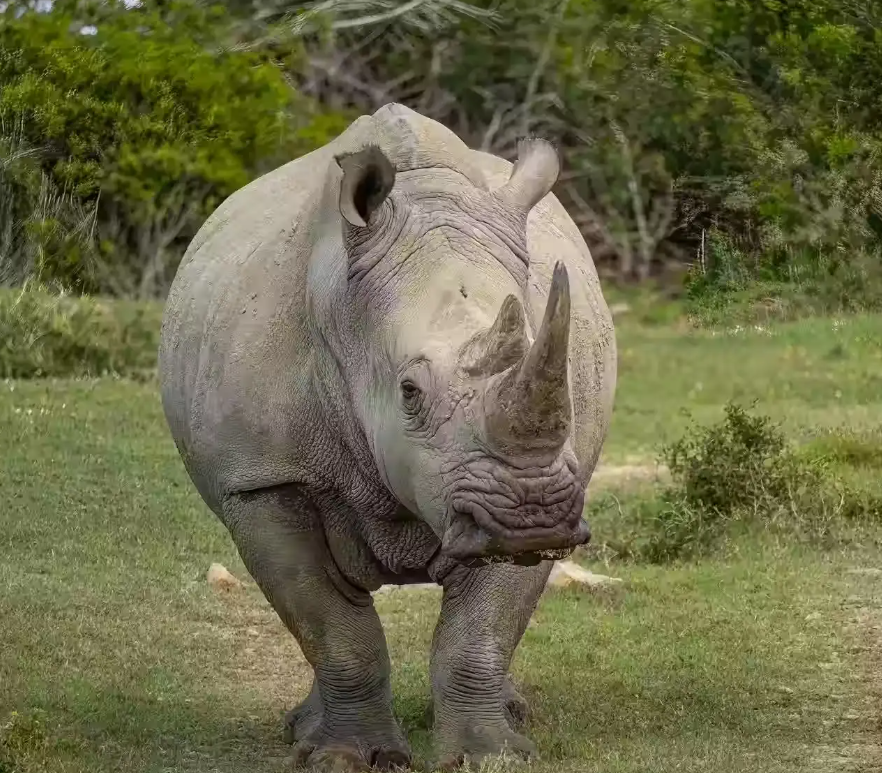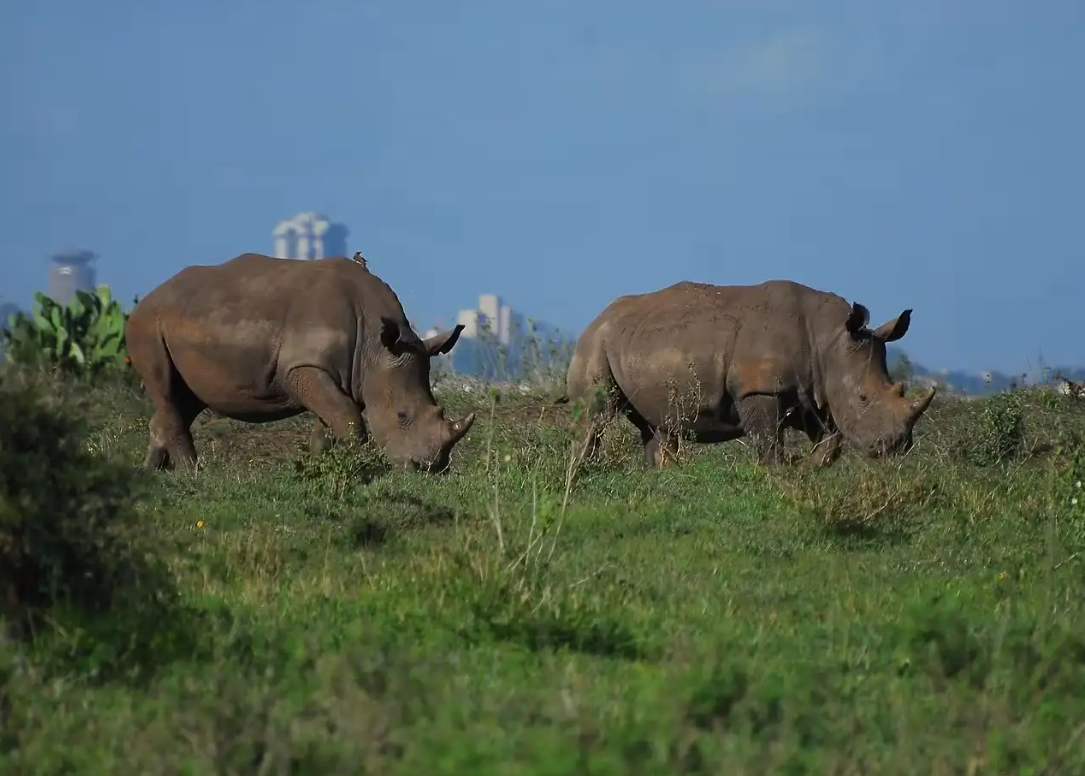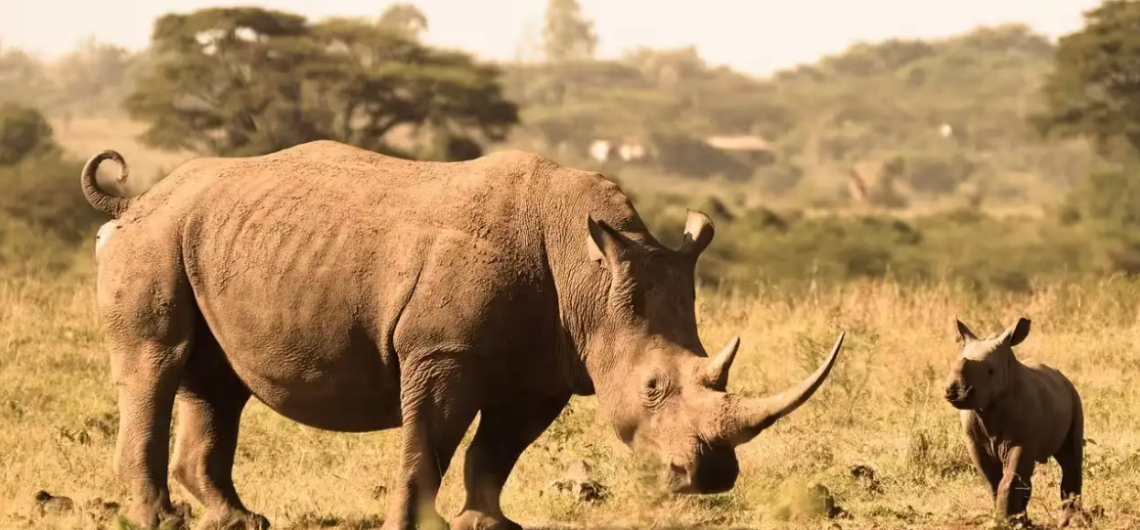The white Rhino
Reading time:5 minutes 26 seconds
Meta description: The white rhino, a member of the African Big Five, is also famously known as the white rhinoceros or the square-lipped rhinoceros.
White rhinoceros
The white rhino (Ceratotherium simum) is one of the largest species of rhinoceros; it is also the second largest mammal after the African Bush Elephant and the most social among the rhino species. The white rhino is known by its wide square lip, massive body size, and its gentle nature. White rhinos are not actually white as their name suggests, but the name is believed to be misinterpreted from the Afrikaans language word “wyd”, which means broad flat mouth, one of their characteristics. Serious efforts have been made by conservationists across the world to save the white rhino from being extinct in the world. The white rhinos suffer a serious threat from poaching and habitat loss.
In Kenya, white rhinos are protected in national parks and some privately owned conservancies, where tourists can visit, see and learn about them.A Rhino in Lake Nakuru National Park.avif
White rhino species
There are only two subspecies of white rhinos in the world:
The southern white rhino(Ceratotherium simum simum): this is the most common species of the white rhino, and it is found in several African countries such as Kenya, South Africa, Namibia and Zimbabwe.
The Northern white rhino(Ceratotherium simum cottoni): this species is considered extinct, with only two females surviving in the world. The two female northern white rhinos named Najin and Fatu are found in Ol Pejeta Conservancy in Kenya. Scientists are working hard to try to save this species from extinction using some of the modern advanced reproductive technologies.
These species once lived in countries like Uganda, Chad, Sudan, and the democratic Republic of Congo. The two species both share similar physical features and behaviour, but they vary in population numbers.
Description of the white rhino
The white rhino is the largest among the rhino species. An adult white rhino can weigh between 1800 to 2700 kilograms, which is about 4,000 and 6,000 pounds. The male white rhinos are heavier than females, where bulls can weigh up to three tons.
The features of the white rhinos include:
Two horns
The white rhinos have two front horns on their snout. The front horn is bigger, growing up to approximately 1.5 metres. Both horns are made up of keratin, which is the same as that in human nails.

Wide square-shaped mouth
The mouth of the white rhino is wide and square-shaped. This is an adaptation that helps it when grazing. This is the unique feature that makes it different from the black rhinos; the black rhinos have pointed lips, which enable them to browse on bushes.
Thick skin
The white rhinos have thick grey skin, which can be up to 5 centimetres thick. Despite having a thick skin, the white rhino is still sensitive to sunburns and insect bites, which is the reason you will see white rhinos rolling in mud to protect their skin.
Large body size
The white rhino is about 1.5metres to 1.8 metres from the shoulder. This large size makes them impressive to watch in the wild during the game drives.
Ears and eyes
The white rhinos have poor eyesight, compensating for it with good hearing and smelling ability. Their ears are able to rotate to detect sound from different directions.
Behaviour of the white Rhinos
The white rhinos are known to be calm and peaceful animals despite having huge bodies. Their general behaviour comprises the following:
Social structure
The white rhinos are more social than the black rhinos. They move, stay and graze in groups known as crashes. The crashes comprise mostly females and calves, which can be up to 10 individuals. The males live in solitude until mating or when having territorial disputes.
Territorial
The male white rhinos mark their territories using urine and their dung. They fight other males to protect their territories, but serious injuries are rare.
Activity
They are active during the morning hours and late in the afternoon. During the day, when the sun is hot, they rest under the tree or in the mud to cool off.
Communication
The wite rhinos communicate through sounds, scent and body language. The mothers and calves use calls to stay connected.
Temperament
The white rhinos are generally calm; they can only charge when they feel threatened, which is mostly caused by their poor eyesight.
Diet of the white rhino
The white rhinos are grazers, meaning they feed on grass. They use their wide, square-shaped lip to clip short grasses. They spend many hours each day grazing, eating up to about 120 kg daily. They also drink water regularly, which is why they stay close to water sources. The water holes provide mud for them to wallow in to protect their skin from insects and parasites and to regulate their body temperatures.
Habitat of the white rhino
The white rhino lives in the savanna grassland where there is abundant grass and plenty of water. In Kenya, they are found in places with short vegetation, scattered trees and water sources such as rivers, swamps and lakeshores.
Reproduction of the white rhino
The white rhinos have a slow reproduction process, which makes them vulnerable to a decline in their population.
Mating
During mating, the males compete for the females in a process of courtship, which is characterised by chasing and nudging, and sometimes it can be rough. The mating can last up to an hour, where the male and female establish a bond.
Gestation
The white rhino pregnancy is very long, taking about 16 months, making it one of the longest gestation periods in the animal kingdom.
Birth
The white rhino gives birth to a single calf, weighing about 50 kg to 60 kg. The mother protects and stays close to the calf for about two to three years.
Maturity
The female white rhino reaches its maturity after about six to seven years, while the male takes 10 to 12 years.
Where to see white rhino in Kenya
The white rhino is found in Kenya, and it is one of the best safari destinations to see rhinos in the wild. Kenya has put more effort into rhino conservation, and several parks and conservancies provide sanctuaries for them.
Ol Pejeta Conservancy
Ol Pejeta Conservancy is located in Laikipia County. It is home to the last two remaining northern white rhinos in the world, Najin and Fat, both of which are female. The conservancy also hosts a good population of southern white rhinos.
Lake Nakuru National Park
Lake Nakuru National Park is located in Nakuru County. It is known as a bird watcher’s paradise because of the millions of flamingos found on its shores. It is also home to both white and black rhinos, which are frequently spotted on its shores.
Nairobi National Park
Nairobi National Park is the only national park found within a capital city in the world, and it is also home to a good population of both black and white rhinos, photographed against the backdrop of the city skyscrapers.

Lewa Wildlife Conservancy
Lewa conservancy in Laikipia, Kenya, is a UNESCO World Heritage Site and one of the most successful conservancies, home to both black and white rhinos, which are constantly under tight security watch.
Solio Game Reserve
This is a private reserve dedicated only to rhino conservation in Kenya, hosting both black and white rhinos.
Aberdare National Park
Aberdare National Park also hosts a small population of white rhinos.Rhinos in Nairobi National Park.avif
Conclusion
Book your Kenya safari today with Dancom Tours and experience the first row of the Kenyan wild. Get to see the white rhino during our game drives together with other magical Kenya wildlife species, including the Big Five and the annual Great wildebeest Migration in Maasai Mara National Reserve


Comments